2025 Subaru Forester Reviews
You'll find all our 2025 Subaru Forester reviews right here. 2025 Subaru Forester prices range from $38,690 for the Forester 25i Awd to $55,990 for the Forester Hybrid Touring Awd.
Our reviews offer detailed analysis of the 's features, design, practicality, fuel consumption, engine and transmission, safety, ownership and what it's like to drive.
The most recent reviews sit up the top of the page, but if you're looking for an older model year or shopping for a used car, scroll down to find Subaru dating back as far as 1997.
Or, if you just want to read the latest news about the Subaru Forester, you'll find it all here.
Subaru Forester Reviews
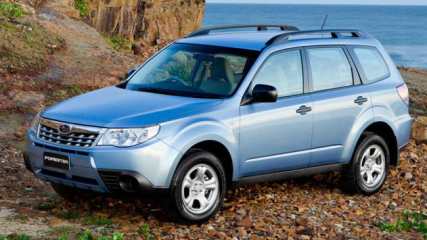
Subaru Forester X 2011 review
Read the article
By Chris Riley · 11 Jul 2011
Whatever Subaru's game plan is, it seems to be working. Sales are up despite the fact that the cars are more generic than ever, with design that ranges from the sublime to the ridiculous.The Forester is a good case in point. Over the years it has morphed from a knockabout, all-wheel drive station wagon into a just another high riding, roly-poly SUV.Be that as it may, earlier this year, Forester became Subaru's biggest selling model of all time, eclipsing even the Impreza — with sales in excess of 150,000 since launch in 1997.It comes as no surprise then that Forester leads the fiercely contested SUV segment in Australia and has done for the past three years.For whatever reason, it has struck a chord with buyers.But one wonders whether time is running out for the niche Japanese car maker, with its "symmetrical" all-wheel drive mantra.The thing is, all wheel drive is starting to lose some of its gloss, with electronic braking systems able to achieve the same level of safety these days.And you end up paying more for all-wheel drive at the pump, because driving all four wheels all the time by necessity pushes up fuel consumption.Having got that off my chest, I'd like to now sing the praises of the new Forester and its new third generation 2.5-litre boxer engine.It might have lost some of its character, but the new model distinguished by a new front grille exudes a real feeling of quality and is a pleasure to drive, with a sporty spring to its step thanks to the Boxer engine.TECHNOLOGYThe new FB engine which makes its debut in the Forester offers no additional power but there has been a small increase in torque.The flat four definitely feels more refined and responsive and the switch to chain drive means no more cam belts to replace.The new engine, the first completely new design in 21 years, puts out 126kW of power at 5800 revs and 235Nm of torque at 4100 revs, with 0-100km/h taking 9.2 seconds.Fuel consumption is rated at 9.3 litres/100km, compared to the previous model's 9.6 litres (we were getting 9.8).Sadly, however, while the engine might be new, we're stuck with the same old five-speed manual or four-speed automatic transmissions, although we're told the auto has been improved.The rest of the world has moved on.Our test vehicle, the base model Forester X with a five-speed manual, has dual range gearing (low and high range).DRIVINGThe engine sounds fabulous and the ride is exemplary, but pushed hard the wagon with its higher centre of gravity exhibits plenty of body roll.Corners taken at speed will spark an extreme reaction from the electronic stability control system.Low range is handy for slippery boat ramps and the like, but off road the Forester can get further than you think in the hands of an experienced driver, with 220mm of ground clearance.Steel wheels are standard fitted with 16 inch Bridgestone 215/65 Duellers and a full sized spare wheel is provided.Inside you get cloth trim and manual airconditioning, but it lacks outlets for rear seat passengers.The dash include a darker finish and darker tone metallic-type highlights for enhanced appearance.Cabin noise levels are reduced through use of an enlarged, higher density, under bonnet noise insulator.Bluetooth is also standard and there's a 12 volt outlet plus AUX and USB ports in the centre console box, with controls for the phone and audio mounted on the wheel.AT A GLANCEPrice: from $30,990Warranty: 3 years/ unlimited kmSafety: 5 star ANCAP2 occupant safety rating , Symmetrical all-wheel drive, ABS, EBD,VDC, SRS Airbags – dual front, dual front side and curtain, Active Head Rests.Engine: Horizontally-opposed Boxer 4-cylinder, petrol engineBody: 5-door WagonTransmission: 5-speed manual transmission, 4-speed automatic transmission with manual mode.Thirst: 9.3L/100km, CO2 220g/km
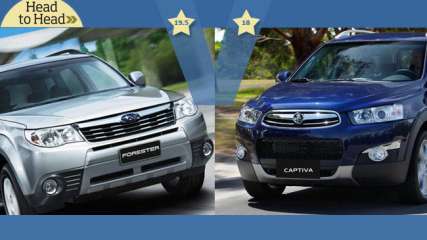
Subaru Forester X vs Holden Captiva
Read the article
By Bruce McMahon · 30 May 2011
Subaru Forester X and Holden Captiva go head-to-head in this comparative review.
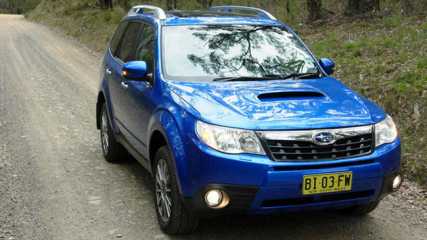
Subaru Forester S 2011 Review
Read the article
By Stuart Martin · 10 May 2011
..,popping and banging sideways through the forests south of Perth. The Forester S-Edition doesn't have a rollcage or the super-grippy rally tyres either, but that's no reason not to give it good consideration.Back on Planet Earth, we have to perform the daily duties - school runs, commuting, family roadtrips and the like - none of which is much fun for passengers in a rally car.Even so, we're driving the most powerful (says Subaru) Forester yet unleashed on Australian roads - remember they've had STi versions of this model in Japan.VALUESubaru is asking $50,990 for the Forester S-Edition - a $3500 jump up from the (25kg lighter) XT Premium automatic.The extra cash buys an additional 24kW and 27Nm, a paddleshift five-speed (the rest of the range has only four and no paddles) auto, STI-style wheels (but the same 17in diameter), the sports interior trim with blue alcantara inserts on the sports leather seats, an upgraded instrument panel and blue hue to the interior lighting.The features list also includes a large electric sunroof, electric folding rear seat function, dual-zone climate control, a six-speaker CD/DVD touchscreen sound and satnav system (which failed to switch screen display when in Auto mode), Bluetooth phone link and a trip computer.TECHNOLOGY The S-Edition packs a solid shove from the re-tuned WRX motor - the turbocharged 2.5-litre flat-four offers 193kW at 6000rpm and 347Nm of torque between 2800-4800 rpm, with variable valve timing among its arsenal.Don't look for any stratospheric ratio tallies here - the Forester S-Edition has the five-speed paddleshift automatic transmission from the WRX STI, which has paddleshifters but feels as though it could do with six gears to keep the 2.5 in the meaty section of the tacho.Given that the rest of the range has a four-speed auto and a five-speed manual on offer, perhaps we shouldn't complain.The all-wheel drive set-up has variable torque distribution - 45/55 front/rear is the norm but it changes as required, something which you get a taste of on the dirt before the electronics kick-in.Even with the driver aids retarded, the nursemaid system still smacks your hand if you attempt to emulate the WRC boys, but swift, secure and sensible dirt road driving is easily achieved without incurring the car's wrath.DESIGNA big, square-rumped bull-nose box with air intakes a-plenty, the Forester has thankfully not yet started to look like the Outback and Liberty.The cabin has a useful amount of room for passengers and cargo, with no shortage of headroom and enough legroom in the back for me to sit behind my own driving position.In-cabin storage is good, with plenty of space in the doors and centre console.SAFETYThe Forester S-Edition has the variable (but not front-biased thankfully) all-wheel drive system, as well as stability and traction control which can be toned down but not disabled, giving it the dynamic ability to avoid misfortune in many cases.The passive safety features include dual front, side and curtain airbags, as well as a reversing camera.DRIVINGThe tall Forester is not all show and no go, that is for certain - 193kW and 347Nm equates to a claim of 6.5 seconds to 100km/h, which is not dawdling for some sportscars, let alone an SUV - gunning away from standstill does little to cast doubt on the numbers.The five-speed auto is smooth but a little on the slow side for shift speed and sometimes get caught snoozing, made worse when the revs fall to the bottom third of the tacho.Flicking the selector across to Sport mode does alleviate some of the tardiness, or the driver can use the elegant paddles behind the steering wheel, complete with grippy rubber backing, but the car will over-rule and up-change rather than tickle the limiter, in the same annoying way the STI auto does.On the plus side, it does have 225mm ground clearance and that is better than many of the alleged soft-roaders, and it will tackle unsealed surfaces comfortably.The Yokohama Geolander tyres fall into the category of Jack of All Trades - useful on most surfaces but not excelling on any either. Early-onset mild understeer is the diagnosis when pushed in corners, with a little bit (but not excessive) body roll, but once settled the Forester covers winding roads at a decent pace - but slower in and faster out being a better cornering option.The S-Edition will also zip quietly through traffic and does it without too much tyre or engine noise (something the STI wanna-haves might miss), riding firmly and with a little too much chatter over the bumps - a check of the tyre pressures revealed normal amounts.The satnav screen is clear and bright, but despite several attempts it would not go to its night display using the Auto mode - a manual change needed to be selected, which can only happen at rest.VERDICTThe top-selling Subaru all-rounder packs plenty of punch and can carry the brood with ease, but it's not yet perfect, better rubber would help.OWNERSHIPPrice: $50,990Warranty: 3 years, unlimited kmResale: 74%Service Interval: 10,000km or 6 monthsEconomy: 10.5l/100km, on test 13.8, 95RON PULP; 248g/km CO2Safety Equipment six airbags, stability and traction control, ABS, EBD.Crash rating: 5 starEngine: 193kW/347Nm 2.5-litre turbocharged flat-fourTransmission: five speed auto, all-wheel driveBody: 5-door, 5 seatsDimensions: 4560mm (L); 1795mm (W); 1700mm (H); 2615mm (WB)Weight: 1585kgTyre size: 225/55 R17 YokohamaSpare tyre: full size alloy

Used first cars review: 2006
Read the article
By Bill McKinnon · 05 Feb 2011
On a tight budget, you had four options: unsafe cars, unreliable cars, really boring cars or cars that combined all three characteristics. In the past decade, though, it's become easier to find a tidy, safe, cheap used car, for several reasons.Firstly, used cars don't hold their value like they once did. New cars have become cheaper in real terms, and sales have boomed, so there's a lot more used cars on the market.Cars are also much safer than they used to be. Government legislation and independent crash test programmes like NCAP, (which publicises the results of its tests, much to the annoyance of the industry) have forced car makers to improve safety. A 2005 car, no matter what make it is, will be safer than a 1995 car. At the minimum, you want two front airbags and anti-lock (ABS) brakes.Unless it's French or Italian, in which case a weekly dummy spit is part of the "ownership experience," most cars from the last 10 years will be pretty reliable, as long as servicing has been done by the book.We are talking about ordinary, everyday cars here, that haven't been thrashed. If you're looking at some dude's slammed, chipped Subaru WRX and the price seems too good to be true, chances are it will self-destruct before you make it home. You pay your money and you take your chances.Immaculate, low kilometre cars owned by little old ladies do exist, and they are gold. So is a complete service record, especially if it's from the dealer who sold the car new. Let's see if we can find a few to recommend. Bottom dollar in our search is $5000.There's not much joy at this money, but the last of the Mitsubishi Magnas, from 2004-2005, are great value and reasonably plentiful. Many will be ex-renters. That's not necessarily a bad thing, because serving will have been done to schedule. The 3.5-litre V6-four speed auto ES has four airbags and ABS.Another Mitsubishi, the Lancer, is the best small car we can find at this price. Toyota Corollas are fine too, though they're more expensive. The Lancer's as sexy as a can of baked beans and completely bulletproof. Pay about $7000-$8000 or so for a 2005 model. Find one with optional ABS and six airbags.If you've got around $10,000 to spend, you have much more choice. In 2004, Mazda made six airbags and ABS available across its entire range, as options or standard, so any Mazda2 or Mazda3 from 2004 on will be worth checking out. Mazda does blue chip quality, and if you find a good one, with a service book, buy it. You'll pick up a 2 for less than $10,000; a 3 will be $10,000-$12,000.If you need something bigger, this sort of money will also get you into a 2004-2005 Subaru Liberty, another top car from Japan's A league. All wheel drive, excellent handling and Subaru's class leading NCAP scores are pluses. The 2.0-litre four won't rip your arms off, but it will do the job. Wagons cost a little more.You might prefer a small SUV wagon instead, so look for a 2004-2005 Subaru Forester, or Toyota RAV4, at $12,000-$15,000. If you need a big car for a big country, the Aussie six is hard to go past.You'll pay $10,000-$13,000 for the first of the VE Commodores from 2006. The 3.6-litre V6 sounds like 1000 leaf blowers on maximum thrust, however it's durable enough. Holden got serious about safety with VE, so you get stability control as standard. It might take a while to find the right car, but in the end, it pays to be fussy. Second hand doesn't have to mean second best.WHERE TO BUY?DealerPros: On cars under 10 years old, most states require a warranty, typically 3 months or 5000 kilometres. You also get guaranteed title. Franchised dealers (ie those who also sell new cars) usually have the best selection of used cars; the trade-ins they don't want are unloaded to non franchised dealers or auctions.Cons: Can be more expensive than a similar car bought privately. Beware of non-franchised dealers selling flood damaged or rebirthed (ie cars written off by insurance companies but then repaired) from Queensland.PrivatePros: The best way to find a bargain.Cons: You have to do plenty of legwork, and finding the right car, in a place that's close to where you live, can be a time consuming process. There's no guarantee of title or provenance, and no comebacks if it drops its guts on the way home. Buyer beware.AuctionsPros: Ex-government or fleet cars, usually properly serviced, with low kilometres. Guaranteed title. Many dealers buy cars at auction, take them to their car yard, and jack the price up by thousands of dollars. Buy it yourself, and pocket the difference.Cons: You can't test drive the car before you bid. It's also easy for an amateur to pay too much, so go to a couple before you buy to get an idea of prices and how it all works.
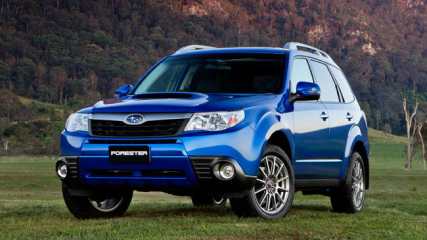
Subaru Forester S-Edition 2011 review
Read the article
By Mark Hinchliffe · 01 Feb 2011
THE Bathurst 12-Hour race this weekend was to be the launch event for the new “performance” model in the Subaru Forester range. However, Subaru boss Nick Senior says there was not a suitable category in the event for the turbocharged S-Edition. Instead, the S-Edition, which had its world debut at the Australian International Motor Show in Sydney last October, was launched on the dusty roads west of Canberra this week.The new flagship “performance” model includes a range of WRX STI components and is the most powerful model in the compact SUV range in Australia.It arrives along with a host of changes to the Forester line-up including a standard reversing camera in most models, more connectivity for iPods and Bluetooth mobile phones and the first new boxer engine since 1989.PRICEThe S-Edition is listed at $50,990, which is $3500 more than the XT model, but it has 24kW more power, 27Nm more torque, leather upholstery and STI 17-inch wheels, turbocharger, intercooler and suspension.Prices for the base Forester X and diesel remain unchanged despite the upgrade in standard features while the price rise in most other models has been kept to $500.Senior also announced that Subaru and Datadot were now offering a refund of customers’ insurance excess if their vehicle is stolen and not recovered in 45 days during the first year.TECHNOLOGYThe S-Edition 2.5 litre boxer engine generates 193kW of power, 347Nm of torque and sprints to 100km/h in 6.5 seconds compared with the XT’s 7.9. It comes with a paddleshift five-speed automatic gearbox and Variable Torque Distribution (VTD) all-wheel drive.The base model petrol Foresters get the new FB naturally aspirated horizontally opposed boxer engine, replacing the EJ unit introduced in 1989. The longer stroke and smaller bore lift low and mid-range torque, decrease emissions and retain the same economy of 9.3 litres per 100km.It also gets a maintenance-free chain drive system replacing the belts. Senior says the engine will be introduced throughout the Subaru range over the next few years.The new FB engine also required changes to the four-speed automatic transmission in the Forester X and XS, while the S-Edition comes in five-speed auto only. It’s a specially tuned version of the paddleshift transmission from the automatic WRX STI.S-Edition gets the STI suspension with softer spring and damping rates and stiffer bushes, while the rest of the range just get the stiffer bushes to reduce pitch and roll.DESIGNOnly Subaru anoraks will notice the exterior changes. The grille is slightly different, the indicators are now in the door mirrors in all but the X and diesel models and there are two new shades of blue paint available.Forester X, XS and XT have black-finish roof rails, while S-Edition gets silver. Inside, the dashboard has a darker finish, a soft feel coating for the instrument panels and new colours. S-Edition gets some extra badging, black and blue alcantara seats, drilled alloy pedals, luminescent instruments and STI wheels.SAFETYAll Subarus have DataDot security and five-star crashworthiness ratings. Now the Forester adds a reversing camera in all but the X and diesel models, regardless of the audio system. However, parking sensors are an optional extra.DRIVINGThe new S-Edition is certainly quicker and more nimble, but it’s not really a performance car. Acceleration is prompt without being electrifying and it’s accompanied by a quite sombre exhaust note.And don’t be put off by the STI suspension componentry because this is not a bone-shaking, kidney-punching ride like the WRX STI.Ride and handling are just about ideal for a dual-purpose vehicle with enough compliance to sort out the lumps and bumps, while keeping the car flat through corners. It is a great improvement on the standard suspension. Models with the new FB engine were not available for test on launch.VERDICTWhile the S-Edition is no STI, you can feel the extra oomph and the ride and handling are greatly improved.This should appeal to a slightly younger audience, although the biggest barrier will be the price tag. Other changes should ensure the range remains at the top of the compact SUV category.PRICESForester X manual $30,990Forester X auto $32,990Forester XS manual $34,990Forester XS auto $36,990Forester XS Premium manual $38,490. With SatNav option: $40,490Forester XS Premium auto $40,490. With SatNav option: $42,490Forester 2.0D manual $35,990Forester 2.0D Premium manual $40,490. With SatNav option: $42,490Forester XT manual $39,990Forester XT auto $41,990Forester XT Premium manual $45,490Forester XT Premium auto $47,490Forester S-Edition auto $50,990
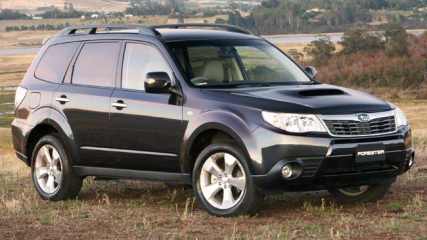
Used Subaru Forester review: 2008-2009
Read the article
By Graham Smith · 03 Dec 2010
Subaru's Forester was at the head of the pack during the SUV stampede 10 years ago and the latest model sought to build upon the huge success of earlier models by pushing for market leadership. The light SUV has become the go-to car for families looking for flexible transport to haul kids to school or sporting events, handle the regular motoring chores and the occasional weekend away.Along the way the market for light SUVs has become one of the most crowded and competitive segments on the local scene and the new Forester was pitted against other hugely popular models like the Nissan X-Trail, Honda CR-V and Toyota RAV4.MODEL WATCHIt's no great secret that the Forester is based on the Subaru Impreza passenger car, so the release of a new Impreza heightened anticipation of a new Forester.When it landed it was larger, fresher and more affordable than those that had gone before. It looked more like a serious four-wheel drive than ever before and was 110 mm taller, 60 mm wider, 75 mm longer, and rode on wheelbase that was 90 mm longer.The increased size was great news for owners wanting more space inside as it delivered more room for rear passengers and more luggage space out back.Overhangs were shortened and ground clearance increased to improve its manoeuvrability. Power for the regular X and XS came from a 2.5-litre 'boxer' four that boasted more power and torque, while the XT had a turbocharged version that was unchanged.At its twin peaks the 2.5-litre gave 126kW at 6000 revs and 229Nm at 4400 revs, enough to make it a lively drive. The turbo meanwhile delivered 169 kW at 5200 revs and 320 Nm at 2800 revs, which made the XT even livelier.Buyers could choose between a four-speed automatic transmission and a five-speed manual, which featured low-range gearing. As with all Subarus the drive went to all four wheels, varying from 95 per cent front and five per cent rear to a 50/50 split depending on throttle, load and speed inputs.Three models were offered in the range, starting with the X and climbing through the XS to the 'Rex-like' XT. Standard equipment on the X included four-speaker sound with steering wheel controls, 16-inch steel wheels, a full-sized spare, as well as air, and power windows and mirrors.In addition the XS boasted front fog lights, alloy wheels, auto air, a CD stacker and six speakers and MP3 compatibility. The range-topping XT got a body kit, larger alloys,and auto-levelling headlights with pop-up washers.There was also a Premium Pack, which added leather,a power driver's seat and a sunroof to the XS, but when added to an XT there was also a touchscreen sat-nav system with DVD/CD player and Bluetooth compatibility.IN THE SHOPWell built and fundamentally sound like all Subarus there is little that goes wrong with the Forester, and that's reflected in the very small number of complaints received at CarsGuide headquarters.There has been the odd question from owners regarding the head gaskets on the Forester's boxer engine, but we're assured by a Suby service specialist that the gaskets themselves are quite sound. While they don't blow as such it is not uncommon to find minor oil leaks around the gaskets, but again we're assured that they are not something to be overly concerned about.Otherwise the Forester is a sound and solid car. Like all used cars it's worth checking for a service record, and consider having an expert check them over.IN A CRASHThe Forester was well equipped to handle a crash situation with standard stability control, anti-skid brakes with brake assist for emergency braking, hill-start assist, and front, side and head airbags. ANCAP's testing gave the Forester five stars out of five.UNDER THE PUMPThe new Forester packed a little more pork than its predecessor but still delivered a little more fuel economy across the range. Those with the regular engine and manual gearbox were a little over three per cent more efficient at 9.3 L/100 km, the auto around one per cent better at 9.6 L/100 km. The turbo improved the most over the previous model, but still guzzled gas at 10.5 L/100 km.LOOK FOR . Fresh look. More cabin space. Improved fuel efficiency. Zippy performance
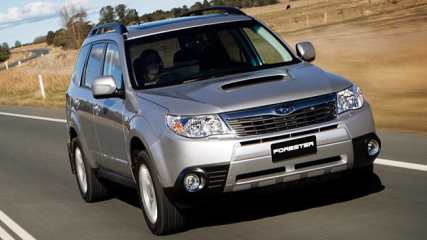
Subaru Forester 2.0D 2010 review
Read the article
By Paul Gover · 29 Jul 2010
ANYONE looking for a compact SUV needs to head to a Subaru showroom. It's been that way for a couple of years, as the Outback and Forester have done the best job for families in Australia. Other SUVs are bigger, flashier and have the rough-and-tough reputation which some people want, but the Subaru pair are the
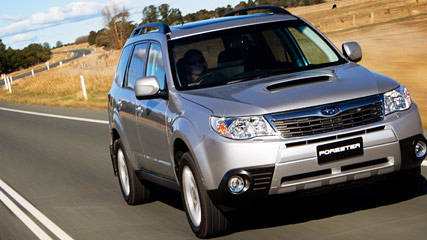
Subaru Forester 2010 review
Read the article
By David Fitzsimons · 01 Jul 2010
If you're going to produce a four-cylinder diesel-engined car with only a manual transmission you have to expect to have a narrow spread of customers. Such a situation faces Subaru which has just unveiled the new Forester 2.0D all-wheel-drive following the earlier release of the diesel Outback.On the negative side the noisy chatter of some diesel engines is a turn-off to many motorists. And the manual gearbox's days of dominance are well and truly gone with most people today driving automatics. Not only do they simplify driving they also have performance levels today virtually as good as a manual.On the plus side, diesels are more economic. They dominate the European landscape where, unlike in Australia, fuel pricing strategies actually encourage people to buy them. Here, diesel economy is still a winner even though diesel prices are usually higher than petrol.In Subaru's favour though is that the Forester is the stand-out smaller AWD on sale in this country. With its high-stance on 16-inch wheels, solid off-road capabilities, roomy interior, practical boxy shape and noted reliability and performance the Forester is as good a place as anywhere for Subaru to stake its claim in diesel sales. And it says the Outback diesel is doing well.PRICING AND EQUIPMENTPriced from $35,990, there are two specification levels for the diesel Forester. For an extra $4000 you can get the top-of-the-range Premium, which scores tinted glass, pockets behind the front seats, a better CD player, 17-inch alloys and a full size alloy spare, an electronically adjustable driver's seat, leather rather than cloth trim and Xenon headlights with their own pop-up washers. You also gain a sunroof which I generally find is the least-used feature in most cars, although other drivers swear by them.Like the petrol version, the diesel Forester has DataDot security to discourage theft and has an extended first term of life as the first service is not needed until 12,500km or six months are reached. Adding to the mix is a suite of five-star safety features including dual front, side and curtain airbags and stability control as standard. It has a three-star pedestrian safety rating.ENGINE AND GEARBOXThe Forester's two-litre flat boxer turbodiesel engine has 108kW of power and 350Nm of torque, driving all four wheels with a six-speed manual. Subaru is claiming just 5.7L/100km fuel economy on the open road and an average of 6.4L including around town.Our week with the car, largely around town, has produced slightly higher fuel use, but with a good-sized (64 litre) tank the range between fill-ups is long, If you can maintain the average you should get 1000km per tank full.It comes down to whether fuel economy (the petrol version is about 3L/100km thirstier) and the enjoyment of manual shifting (particularly out of the city limits) are important enough to you to opt for the oiler.DRIVINGThat torque level starts way down, producing some solid pulling power in the low gears. Around town it is a comfortable drive, that torque gets it away from the traffic lights impressively. With six gears on hand you will find yourself with a couple to spare at city speed limits such is the mid-range power. The shifting is quite light, particularly from 2nd to 3rd and the car has a hill-start assist feature to reduce any chance of rolling back when starting on an incline. It's actually a pity more people don't like manuals as this is a neat little box.The sound of the diesel engine is loudest at low revs and fades away when you're cruising. It's not as bad as some diesels we have driven but you do notice it. We didn't hit the dirt or tow anything but reports from its recent launch event suggest it is a winner there.Poor rear vision is a problem in many cars, particularly big off-roaders today, neccessitating rear vision cameras. The high stance of the Subaru and a wide rear window gives better rear visibility than many other vehicles.Inside there's an overall black feel. The seats are black, the dash is black and the dials aren't particularly bright. But, there's plenty of leg and head room in both passenger rows. The sound system though is good for the price and there are steering wheel controls to change the volume etc.At the rear the hatch is opened manually while the level of the boot is at a good height for average sized motorists. There's plenty of storage space in the back even with the second row of seats in place. We loaded a full-size folding bicycle into the rear with ease, although there wasn't much room left for anything else.The diesel Forester won't appeal to everyone. The petrol version of the Forester is a fine car already. It’s the fuel economy that will be the decider for some.RATING: 80/100THE BOTTOM LINE: Solid, practical and versatile car that with a diesel powerplant and manual-only transmission is restricted in its appeal. And there's nothing wrong with the petrol version.SUBARU FORESTER 2.0 DIESELPrice: from $35,990Engine: 2L/4-cylinder 108kW/350Nm turbodieselTransmission: 6-speed manualEconomy: 6.4L/100km (official)RIVALSVW Tiguan 2.0 TDI from $36,690Hyundai ix35 2.0 diesel from $34,990Nissan x-Trail 2.0 diesel from $37,740Land Rover Freelander 2.3 TD4e from $45,590Subaru Outback 2.0D from $40,490
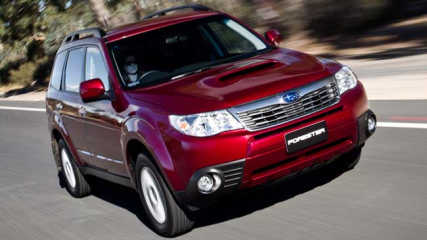
Subaru Forester 2.0 diesel 2010 first drive review
Read the article
By Karla Pincott · 01 Jun 2010
There are a lot of reasons why you would buy the Subaru Forester 2.0 diesel, and really only a single one that might prevent you. The hurdle is the six-speed manual transmission, which is noticeably notchy when you first shake hands with it and – while it becomes more pleasant on further acquaintance – is hard to warm to.EngineBut that out of the way, one of the first reasons to put the Forester on your compact SUV list is the new engine. It’s the four-cylinder turbo-diesel boxer (flat) unit from the Outback, which claims a combined fuel economy of 6.4L/100km, dropping to 5.7L on the highway and still maintaining a creditable 7.5L around town. That frugal thirst results in emissions of just 168g/km of CO2 (151g/km highway), which puts it well in range of many mid-sized passenger cars.But it’s no wimp, developing 108kW of power at 3600 revs and 350Nm of torque from 1800-2400 revs – with just 10Nm less at a very low 1600 revs. That helps it to a 1600kg braked towing capacity, which is 200kg more muscle than its naturally aspirated petrol siblings. And that torque is going to all four wheels with Subaru’s signature all-wheel drive system.Package and safetyThe Forester is roomy for its size, with plenty of legroom front and rear, and ample cargo space for a few suitcases even before you think of putting the rear seat down.The cabin is comfortable and well-designed, with the only downsides being the flattish seats, and Subaru’s insistence on a satin metalised dash insert that stands out loudly from what is otherwise a well-shaped sweep of dash. The SUV’s extra ground clearance makes for a high-ish load level into the back, but its easily manageable.A five-star ANCAP crash rating has been given to the strengthened and reinforced body and its battery of safety technology, including stability and traction control, active headrests, anti-lock brakes with brake assist and brake force distribution, plus dual front/side/curtain airbags.Price and equipmentThe standard Forester is priced from $35,990 and kitted out 17-in alloy wheels, self-levelling suspension, DataDot security, roof rails and a four-speaker CD/audio player system.The $39,990 Premium level adds 17-in alloys, electric sunroof, leather upholstery, tinted glass, a CD six-stacker, eight-way power adjustment on the driver’s seat, and self-levelling xenon headlights with pop-up washers.DrivingOver the past few years we’ve become fairly used to the voice of diesel engines – some have even started to sound enjoyable. The Forester’s turbo-diesel isn’t yet one of them, but only because it’s let down by some clatter appearing at lower revs. This becomes muted once you get further under way, and wasn’t noticeable at all until we turned the stereo off.But the sound is secondary to the substance. And this engine steps up to the plate. It’s strong and tractable, with more torque than we could soak up on the test drive through hilly roads both on and off the blacktop. The steering was responsive, although it felt oddly light over the dirt roads.And while we were pleased with the Forester’s ride and well-balanced manners on the sealed surfaces, it was on the sections of potholed and corrugated dirt that it really proved its strengths. These are the kind of washboard stretches that could have lesser vehicles skittering around like marbles on a vibraplate, but the Forester handled it all capably.You could feel the surfaces, no question, despite the best efforts of the suspension. But there was never any hint that they would unsettle the little SUV’s composure, and we zoomed over them in perfect confidence.Subaru originally launched the Forester as ‘the city car for dirty weekends’. We’re not sure about the city life with that manual gearbox, but there’s no doubt that for anybody who wants to get beyond the urban boundaries – fishing in secret spots or heading down little-used tracks to remote beaches – this is a vehicle to consider.Subaru Forester 2.0 dieselPrice: from $35,990Engine: 2.0-litre turbodiesel four-cylinderTransmission: six-speed manual

Mums test SUVs
Read the article
By Paul Gover · 03 Feb 2010
Some fall for the high-riding visibility, many feel safer, and a vast majority realise a versatile wagon is the best way to meet the changing and demanding needs of a 21st century lifestyle.Large four-wheel drives were easy to dismiss as high-priced Toorak Tractors less than 10 years ago, but today's SUVs have flooded every area of new-car showrooms. They come in every size and most price ranges, from compact $20,000-somethings right through to Range Rovers and Porsches with showroom stickers in the $200,000 range.Women with families were originally forced into suburban work with four-wheel drives which were bought as weekend escape machines, but nowdays there are dozens of SUVs which have been designed to meet the real needs of women.Nissan even created a virtual woman — 50-something, independent and successful, kids away from home — when it was developing its latest Murano SUV. The result is a car that's fine for blokes but ticks the boxes for females. So, what do some regular Australian women think about a range of the most popular SUVs sold in Australia today?Claire Heaney road-tested the Subaru ForesterMum of Hannah, 10; Patrick, 8 and Lucy 5.There was much excitement when I told the kids we were getting a new car - for the weekend. That was tinged with horror when they learned I, and not their father, would be in the driver's seat.They think I am a candidate for one of the ‘worst drivers’ shows on telly. And they also hate the fact that when they start clobbering each other I pull over to the side of the road until they promise to stop. Nonetheless, they waited with anticipation when I left to collect the new car - a Subaru Forester AWD wagon.First impressions were pleasing. It was lovely - black, sleek, not too big and fitted with roof rails. Then, as I was handed the key, I was told it was a manual. I was struck with fear. Once I got it reversed, I kangaroo hopped home.The kids gave the car the once over, giving it the thumbs up. Although the eldest thought the black duco looked a bit "Goth". Seating negotiation was finalised. Our own car is a Toyota Avensis, a small seven-seater that fits the three kids easily. It also means they are separated over two rows of seating. No fighting over window seats.We popped the bulging booster seat in the middle and I turned myself inside out to buckle them in. Their dad reluctantly slid himself into the front passenger seat. White knuck led, it reminded me of my Dad trying to teach me how to drive.Fairly soon, I was working my way up through the gears with ease. There were a few hiccups such as when we stalled on the Westgate Freeway. "Hey, this isn't a carpark," my eldest advised. But once we were out of town and headed for Torquay it came into its own. We noted what a smooth and quiet ride the Subaru offered.I experimented with the cruise control but the dual range, providing for low gear if you are driving in sand or up a steep hill, wasn't needed. The seating, once I remembered it did not have armrests, was really comfy. There were upsides about only have three seats on offer. We avoided the usual badgering about whether a friend could accompany us on our outing. "It's just us today, guys, we can't fit anyone else in," I told them, barely able to suppress my delight.Sitting side-by-side there was a bit of elbowing and poking going on but the upside was the great wagon space. We had no trouble fitting a picnic, beach bags, boogie boards and other things that would normally be tricky.Although we are getting to the end of child seats, the clever child restraint attachments would have been welcome not so long ago. I also loved the ease in which one or both the back seats could fold down to create a very big space at the back.While we may have outgrown such a car, we could see why they are so popular. Two kids at the back, with the armrest and drinks holder and easy on the fuel would be in heaven.Likes:Great fuel efficiency.Armrests and drink holders in the back.Stylish design.Dislikes:Bit cramped for three kids in the back.I'd go crazy trying to keep a black car clean - so bear that in mind when choosing the colour.Wendy Tuohy road-tested the Toyota LandcruiserMum of Angus 11, Lachie 10 and Eliza, 6This car is not a runabout. In fact, employing its 2.5 tonne, V8 grunt for the school run or supermarket is like saddling up a stallion for the St Kilda pony rides. Not that driving it isn't a heap of fun.With awe-inspiring power and excellent suspension -- and much better cabin stability than you'd expect being so high off the ground -- tooling around in Cruiser is a driving novelty.Everything about it is big, including the gas-guzzling, 4.7 litre engine. It seats eight, and space in the middle row is so generous it feels about like the whole interior of a smaller car. The outsized rear vision mirrors offer panoramic views, and the storage compartment in the front console is big enough to hold a handbag -- or small gas bottle, if you are using this as the luxurious bush tractor it so obviously is.And you could almost fit a Smart Car in the boot. But for all its size, the LandCruiser is surprisingly easy to handle.Thanks to a range of new high-tech features, steering is light and agile, and stopping is unexpectedly smooth. Though in the city, you find yourself riding the brakes a lot.The five-speed auto engine takes off and effortlessly gathers speed as if itching to head straight for the open road -- not the next set of lights. Because of its ample space and many creature comforts (leather seats, four temperature zones, sun roof, 10 air bags) you can understand why these took off as people-mover alternatives.But given its power, weight, and the fact its impact zone with a normal car would be at their head-height, it's also understandable why many disapprove of urban Cruiser use. Let alone the carbon cost. And reverse parking is a drag.Sure, reversing cameras help but the LandCruiser just isn't an easy vehicle to back between two normal cars outside the local shops.But try one for the fun. Men will look at you like they want to jump in -- women like they'd rather shoot the tires out.Likes:Interior spaceDriver and passenger safety featuresExcellent power steeringDislikes:Hard to reverse parkBlocks other drivers view of the roadToo much power for townRuth Lamperd road-tested the Kia Carnival GrandMum of Joe, 10; Daniel, 8 and Charlie 5Moving three children and their friends around the suburbs means practicality overtakes image on the freeway of life. While diesel people mover, the Kia Carnival Grand, looks a lot like any other uninspiring longish-nosed van from the outside, its high-end versions on the inside offer luxuries that make the grown-ups feel a little like royalty.Buttons operate nearly everything and dual air conditioning with personal vents stop squabbles among the passengers. There are no more heaving on sliding doors or swinging off upward opening boot doors. Power operation makes entering and exiting simple enough for even five-year-olds to manage. That means far less work and bother for the big people.The steady flow of childrens quizzing from the back seats are easily heard by the driver thanks to good insulation from road and engine noise. This is in spite of the diesel engine making it sound more like a truck from the outside than an eight seater van.A power lag from a standing start like pulling from a side street into a space in a busy road is nearing danger levels if not in reality, at least in driver perception. Stick your foot to the floor and about a second will pass before you feel any real power and then it comes on so strong that you are pushed firmly back into your seat from the delayed acceleration.It can provide some scary moments in traffic and belies the ample power otherwise under the bonnet. Hitting the speed limit on a freeway happens deceptively easily and ensures the cruise control albeit a bit shaky in its sensitivity gets a good workout. There are airbags at every turn and in the event of a head-on crash, manufacturers reassure the nose collapses downwards, ideally leaving drivers legs intact.Good driver vision of surrounding traffic is impressive. In the child-friendly stakes (although we didnt test what happens when slow-closing power doors if a kids finger is in the way) its right up there.A pop-down fish-eye mirror affords the driver a view of little passengers in the back two seat rows. Anything which gives mum a mythical set of eyes in the back of her head has got to be good.Likes:Power doorsEase of folding down seatsDislikes:Weak airconditioningLag on take-off




